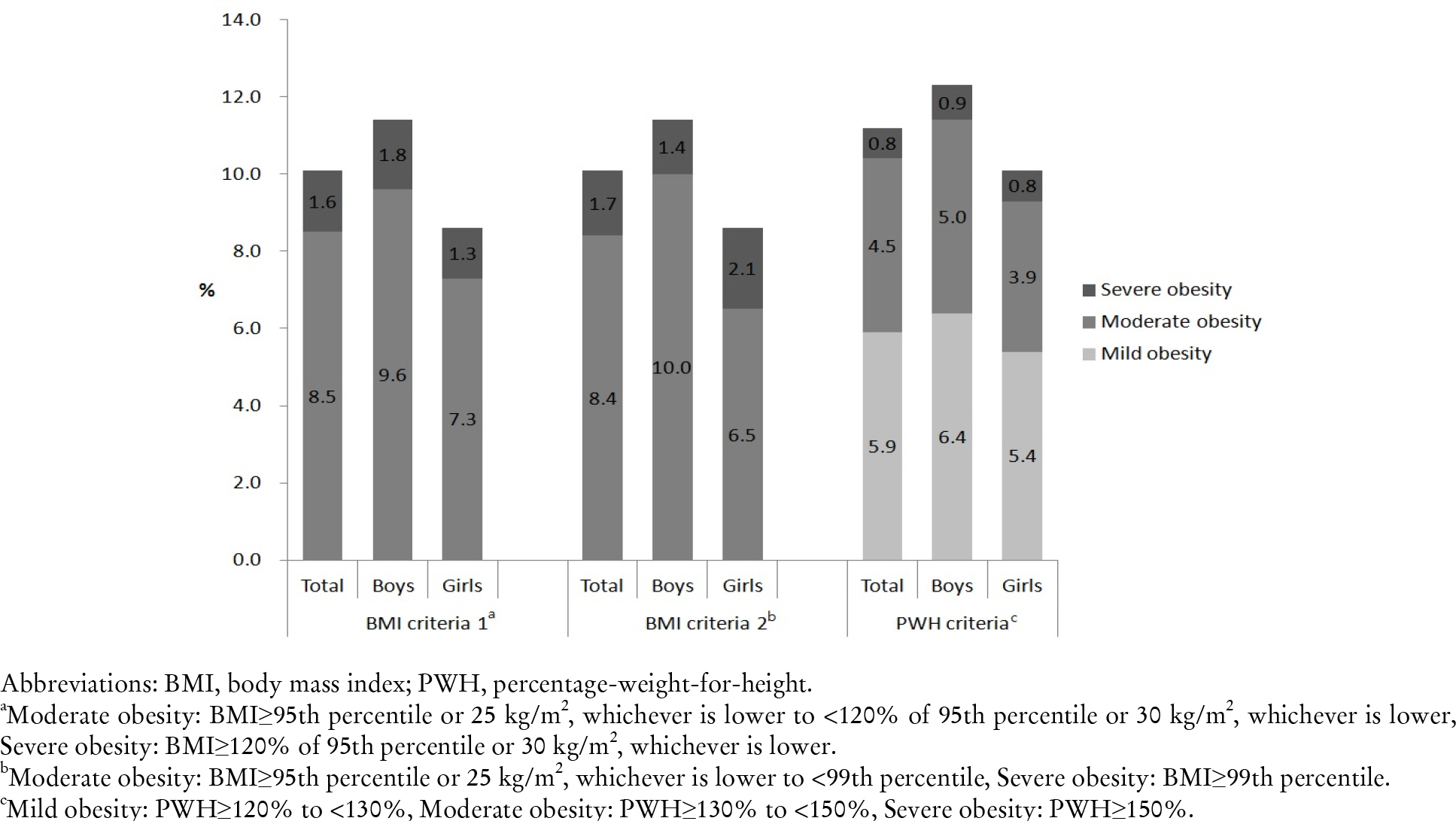Korean J Health Promot.
2016 Sep;16(3):174-179. 10.15384/kjhp.2016.16.3.174.
Diagnosis of Severe Obesity in Korean Children and Adolescents
- Affiliations
-
- 1Institute for Clinical Nutrition, Inje University, Seoul, Korea.
- 2Department of Family Medicine, Seoul Paik Hospital, Inje University College of Medicine, Seoul, Korea. jacobel@hanmail.net
- KMID: 2354621
- DOI: http://doi.org/10.15384/kjhp.2016.16.3.174
Abstract
- BACKGROUND
Although the obesity prevalence in Korean children and adolescents has stabilized since early 2000s, it is noted that severe obesity is increasing. However, no diagnostic criteria to define severe obesity in Korean children and adolescents has not been recommended yet.
METHODS
We established two kinds of diagnostic criteria of severe obesity with the 2007 Korean National Growth Charts; 1) body mass index (BMI) criteria 1: BMI≥120% of 95th percentile or 30 kg/m², whichever is lower, 2) BMI criteria 2: ≥99th percentile. We examined the prevalence of severe obesity among children and adolescents who participated in the Fifth Korea National Health and Nutrition Examination Survey, 2010-2012 based on BMI criteria 1 and 2 as well as percentage-weight-for-height (PWH).
RESULTS
We presented the age- and sex-specific BMI cut-offs of BMI criteria 1 and 2. The prevalence of severe obesity was 1.6% and 1.7% based on BMI criteria 1 and 2, respectively. The prevalence of severe obesity based on PWH was 0.8%, which was lower than the prevalences based on BMI criteria 1 and 2.
CONCLUSIONS
Our diagnostic criteria of severe obesity can be utilized in the epidemiological surveys and researches before the recommendation of the formal diagnostic criteria.
Keyword
MeSH Terms
Figure
Reference
-
References
1. Bahk J, Khang YH. Trends in measures of childhood obesity in Korea from 1998 to 2012. J Epidemiol. 2016; 26(4):199–207.
Article2. Ministry of Education. The results of school health examinatio n sample survey [Internet]. Sejong: Ministry of Education;2016. [Accessed April 15, 2016]. Available from:. http://www.moe.go.kr/web/100026/ko/board/view.do?bbsId=294&pageSize=. 10¤tPage=3&encodeYn=Y&boardSeq=62361&mode= view.3. Skinner AC, Perrin EM, Moss LA, Skelton JA. Cardiometabolic risks and severity of obesity in children and young adults. N Engl J Med. 2015; 373(14):1307–17.
Article4. Barlow SE. Expert Committee. Expert committee recommendations regarding the prevention, assessment, and treatment of child and adolescent overweight and obesity: summary report. Pediatrics. 2007; 120(Suppl 4):S164–92.
Article5. Kelly AS, Barlow SE, Rao G, Inge TH, Hayman LL, Steinberger J, et al. Severe obesity in children and adolescents: identification, associated health risks, and treatment approaches: a scientific statement from the American Heart Association. Circulation. 2013; 128(15):1689–712.6. Centers for Disease Control and Prevention. 2007 Korean children and adolescents national growth chart: commentary [Internet]. Cheongju: Centers for Disease Control and Prevention;2007. [Accessed April 15, 2016]. Available from:. http://www.cdc.go.kr/CDC/notice/CdcKrInfo0201.jsp?menuIds=HOME0. 01-MNU1154-MNU0004-MNU1889&cid=1235.7. International Obesity Task Force. The Asia-Pacific perspective: redefinining obesity and its treatment. Sydney: Health Communications Australia Pty Ltd;2000.8. Flegal KM, Wei R, Ogden CL, Freedman DS, Johnson CL, Curtin LR. Characterizing extreme values of body mass index-for-age by using the 2000 Centers for Disease Control and Prevention growth charts. Am J Clin Nutr. 2009; 90(5):1314–20.
Article9. Skinner AC, Skelton JA. Prevalence and trends in obesity and severe obesity among children in the United States, 1999–2012. JAMA Pediatr. 2014; 168(6):561–6.
Article10. Li L, Pérez A, Wu LT, Ranjit N, Brown HS, Kelder SH. Cardiometabolic risk factors among severely obese children and adolescents in the United States, 1999–2012. Child Obes. 2016; 12(1):12–9.
Article11. Chung S. Management of severe obesity in children and adolescents. J Korean Soc Pediatr Endocrinol. 2010; 15(2):85–92.12. Cole TJ, Lobstein T. Extended international (IOTF) body mass index cutoffs for thinness, overweight and obesity. Pediatr Obes. 2012; 7(4):284–94.
Article13. Seo JY, Cho YG, Kang JH, Hur YI, Park HA, Kim KW, et al. New diagnostic criteria for obesity and overweight in Korean children and adolescents using 2007 Korean National Growth Charts. Obes Res Clin Pract. 2013; 7(3):e182–9.
Article14. Oh SW. Diagnostic criteria for childhood obesity. Korean J Obes. 2008; 17(4):188–90.
- Full Text Links
- Actions
-
Cited
- CITED
-
- Close
- Share
- Similar articles
-
- Dyslipidemia in Children and Adolescents: When and How to Diagnose and Treat?
- Management of Severe Obesity in Children and Adolescents
- Obesity and Metabolic Syndrome among Children and Adolescents in Korea
- Management of Obesity in Children and Adolescents: Staged Care Approach
- Cutoff values of body mass index for severe obesity in Korean children and adolescents: the 99th percentile versus 120% of the 95th percentile


